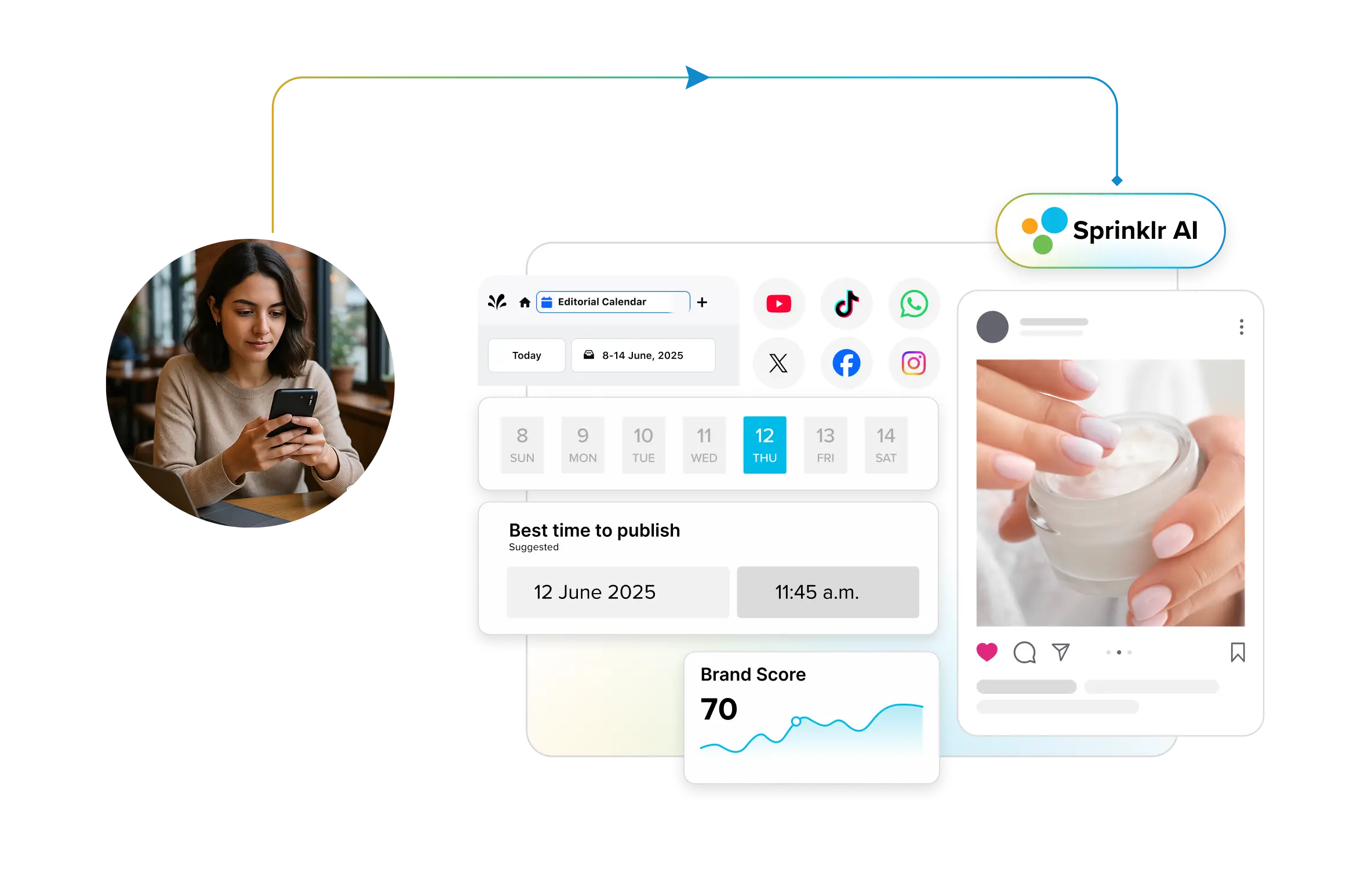The global leader in enterprise social media management
For over a decade, Sprinklr Social has helped the world’s biggest brands reimagine social media as a growth driver with a unified platform, industry-leading AI and enterprise-grade scale.

Social Media at Enterprise Scale: Cost, Complexity, and the Case for Unification
You know that feeling when you’re trying to bail out water with a teacup in a leaky boat, only to realize the tide is rising faster than you can keep up?
That’s what managing social media often feels like for big companies today. With new channels popping up everywhere and the demand for content skyrocketing, it can feel like your team is constantly stretched thin.
On top of that, data is scattered across different platforms, dashboards, and inboxes, making it even harder to find your footing. Many marketing leaders are grappling with a tough question: Is all this investment in people, channels, tools, and content really paying off?
According to the CMSWire State of the CMO Report 2025, 69% of CMOs say leadership now expects measurable results for every initiative, while 95% of marketing leaders report increased pressure to prove ROI. That scrutiny has turned the spotlight squarely on tech, especially where it promises speed, scale, and measurable impact.
The rise of Generative AI, AI-powered content workflows, and platform-based operations has made one thing clear: it's time to rethink the balance between people and technology in enterprise social media operations. However, that doesn't mean blindly automating everything or doubling the team's headcount.
It means stepping back and asking, 'What's truly scalable?' What brings efficiency? What delivers consistency across markets, channels, and teams?
In this blog, we're not taking sides; we’re laying everything out on the table. We’ll explore the growing tension between the expansion of cross-functional social media teams and the need for a unified social media management platform. We’ll dig into where the real potential for scale lies and highlight the risks of having a narrow focus that could end up costing you more than you realize.
- Enterprise Social Media Management: Unified Platforms vs. Bloated Teams
- Why “more headcount” isn’t a scalable solution
- Why tech-driven unified social management gaining momentum
- Unified platforms vs. fragmented teams: Common myths vs. reality
- How top enterprise brands handle social media
- Microsoft: Making sense of the noise at scale
- Pillar Marketing Corporation: Scaling community without losing the human touch
- From chaos to coordination: How a global bakery saved 800 workdays across 30 countries
- Automation-first is people-first: Let’s get that straight
Enterprise Social Media Management: Unified Platforms vs. Bloated Teams
Why “more headcount” isn’t a scalable solution
For years, the default fix to growing social media complexity was simple: add more people.
More channels? Hire a channel specialist.
More regions? Bring in regional leads.
More social media campaigns? Stack the team with content creators, analysts, and community managers.
But here’s the truth enterprise leaders are confronting today: more headcount doesn’t equal more efficiency. It often leads to the opposite — fragmented workflows, redundant processes, inconsistent brand messaging, and skyrocketing overhead.
In large enterprises, bloated social media teams tend to operate in silos. Regional teams use different tools, campaign leads build their own workflows, and reporting standards vary wildly from one team to the next.
Without centralized publishing workflows or unified oversight, brand governance becomes reactive instead of strategic. And the inconsistencies are most evident in the areas that matter most: customer experience, campaign performance, and brand perception.
Worse, these fragmented team structures become expensive liabilities during internal audits or leadership reviews. When marketing leaders are asked to show ROI, justify team size, or explain overlapping roles, the cracks start to show. Leadership starts asking: Why do we have 10 people posting the same content in seven slightly different ways?
Just to clarify, this is less of a budget concern and more of a brand risk. Without transparent governance and standardized workflows, you’re leaving yourself vulnerable to off-brand messaging, social media compliance risks, and missed opportunities.
Breaking these silos is critical. The modern enterprise doesn’t need more people chasing content deadlines. It needs cross-functional social media teams aligned on a single platform-based social operations model, with centralized publishing workflows, shared visibility, and AI-powered content coordination that scales intelligently, not chaotically.
In short, scale shouldn’t come from duplication. It should come from orchestration. Let’s see the role technology plays here.
Why tech-driven unified social management gaining momentum
Tech advocates argue that unified social media management tools like Sprinklr Social are fundamentally reshaping how brands operate socially at scale. Here’s why their case proves the point:
- Faster execution, fewer handoffs: Unified social media management platforms cut down the clutter. You no longer need five teams and three tools to launch a global campaign. Centralized content publishing workflows enable teams to coordinate in real-time, reuse approved assets, and localize content with precision, eliminating the need to reinvent the wheel for every market.
- Consistency meets control: For brands operating across multiple regions, consistency is critical. Unified social media management tools help enforce brand governance at scale, ensuring the social media tone of voice, visuals, and values remain aligned across every channel, no matter who’s hitting publish. BOOK SPRINKLR SOCIAL DEMO
- Intelligence baked in, not bolted on: With AI-powered content workflows and real-time social reporting built natively into unified platforms, teams spend less time pulling numbers and more time acting on them. For example, instead of waiting a week for manual campaign reports, a retail brand can now see mid-campaign performance trends in real time, and instantly shift budget toward high-performing creatives while pausing underperforming ones.
- Security, compliance, and audit readiness: In a world where a single social slip-up can spiral, enterprise-grade platforms provide controlled access, role-based permissions, and detailed audit logs. Think of a global bank managing dozens of regional accounts. Instead of interns accidentally publishing from the corporate handle, every post passes through pre-set approval workflows, with a full audit trail ready for regulators if needed.
Two cents from Sprinklr
What tech advocates are really championing is that social media is no longer a channel; it’s an enterprise function and like any mission-critical function, it demands a single source of truth, not a tangle of tools and teams.
That’s why we’re seeing a wave of large enterprises migrating to platform-based social operations, tools that aren’t just built for publishing but for aligning teams, automating governance, and scaling impact globally, something that Sprinklr Social is known for industry-wide. Explore some of the most complex social challenges solved by Sprinklr.
Unified platforms vs. fragmented teams: Common myths vs. reality
When marketing leaders push for a unified social media management platform, CEOs and CFOs ask tough but fair questions:
"Isn't software expensive to implement and hard to scale?"
"Aren't our regional teams already handling social just fine?"
The answers, when you break them down through an enterprise lens, tell a very different story and bust some of the biggest myths:
Common myth | Reality |
| More often, people create silos, resulting in slower execution and inconsistent workflows. Unified platforms streamline processes with centralized publishing workflows, automated approvals, and AI-powered content suggestions. |
| |
| |
| |
| |
How top enterprise brands handle social media
For most enterprise brands, social media isn’t run in isolation. It’s directly tied to business objectives — from driving demand and managing online brand reputation to supporting employer branding and delivering superior customer experience.
To stay aligned, goals are typically broken down by region, department, or product line. Engagement, reach, conversions, and share of voice are standard metrics used to measure success across these layers.
Many leading brands rely on Sprinklr Social to manage their day-to-day social operations. More importantly, they adopt unified social media management to simplify complex processes, scale efficiently, and bring order to otherwise fragmented workflows. Here are three examples that show what that looks like in practice.
Microsoft: Making sense of the noise at scale
When a company is mentioned over 100 million times a year on social media, the challenge isn’t just being present; it’s knowing where to listen, when to act, and how to do it efficiently.
That was the problem Microsoft set out to solve. Their social teams were navigating a maze of point solutions, spending too much time switching tools and too little time engaging meaningfully. With dozens of community managers and no single source of truth, workflows were fragmented and opportunities were slipping through the cracks.
Their pivot was to centralize all social media engagement into one system, streamlining how they publish, monitor, and respond in real time. What used to require toggling between tools is now handled through a single, unified interface, helping teams filter out the noise and focus on high-impact conversations.
The result is stronger, faster, and more authentic customer connections without adding headcount or compromising scale.
Pillar Marketing Corporation: Scaling community without losing the human touch
Managing fast-growing online communities across multiple brands can feel like trying to steer several ships at once — especially when content, approvals, and insights are all living in different places. Pillar Marketing Corporation, with client brands such as Cheech & Chong's Global Holdings and Mary Jones, among others, discovered this the hard way as they attempted to build authentic brand engagement across distinct audiences, each with its own unique voice and momentum.
Their breakthrough came not from adding more hands to the operation, but from aligning behind a more innovative and connected way of working. What followed was faster turnarounds, sharper content decisions, and measurable growth, including a $1M revenue lift for one brand and a doubling of engagement for another.
It's a reminder that when storytelling is backed by operational clarity, community-building becomes not just possible but powerful. Here is what their founder and CEO says::
"There's simply nothing out there that operates at this level and does what it says it will do."
— Ben Mason, Founder & CEO, Pillar Marketing Corporation.

From chaos to coordination: How a global bakery saved 800 workdays across 30 countries
Take the case of a global food brand operating in over 30 countries. Each region manages its own social presence — different tools, different metrics, different ways of working. They had solutions for publishing, listening, and customer care, but none of them spoke to each other. The result was siloed teams, duplicated efforts, and hours spent stitching together inconsistent reports.
To fix this, they unified their social operations under a single model. Now, campaign calendars are shared, customer messages are automatically categorized, and reporting follows a consistent, global standard.
The impact: hundreds of workdays saved, real-time visibility into performance, and a scalable system that doesn't rely on adding more tools or people.
This is exactly what happens when teams move from fragmented tech stacks to unified platforms: less chaos, more clarity, and smarter decisions at every level. Read Full Story Here

Automation-first is people-first: Let’s get that straight
Let’s be clear — this isn’t about technology replacing people. It’s about enabling them.
The conversation around automation is often framed as a trade-off: technology vs. talent, efficiency vs. empathy, speed vs. strategy. But that’s a false choice. At its best, automation doesn’t cut people out of the equation; it frees them up to do the kind of work that truly moves the needle.
When enterprises adopt a unified social media tool, the real win isn’t just faster publishing or more intelligent reporting. It’s this:
Teams no longer have to toggle between siloed tools, spend hours on manual reporting, or feel buried under the sheer volume of social data. Instead, they gain a streamlined workflow, a clear view of customer conversations, and more time to create, strategize, and shape the brand experience.
That’s the heart of the shift: an automation-first mindset is inherently a people-first approach. Because today, the smartest move a company can make isn’t choosing between tech and talent; it’s empowering the right people with the right tools. That’s how you scale connection, not just output.
If you’re curious how a unified social platform can help your teams work smarter — not harder — take a closer look at Sprinklr Social. It’s built for enterprises that want efficiency without compromise, automation that empowers people, and scale that still feels human. Ready to see in action?









